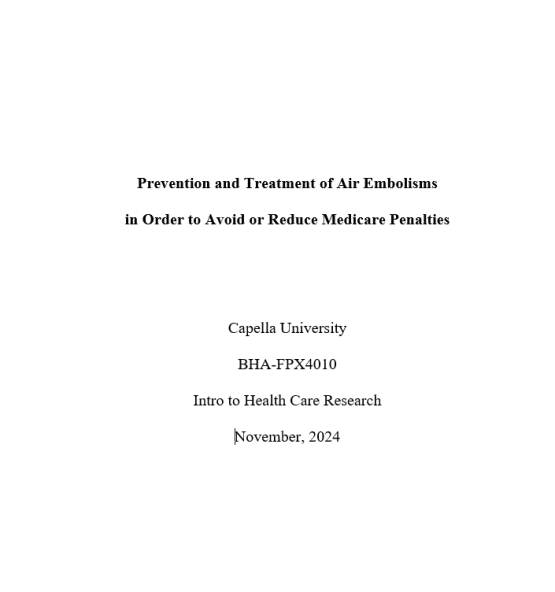
Prevention and Treatment of Air Embolisms
in Order to Avoid or Reduce Medicare Penalties
Capella University
BHA-FPX4010
Intro to Health Care Research
November, 2023
Availability:In Stock
Prevention and Treatment of Air Embolisms
in Order to Avoid or Reduce Medicare Penalties
Background
Medicare has designed a by-law that reduced payments to hospitals or medical facilities that have high rates of Hospital-Acquired Conditions (HAC) (National Conference of State Legislatures, 2008). According to McNair et al. (2020), Medicare finds it hard to justify paying the hospital for the types of substandard care that result in HACs. Therefore, Medicare has implemented a program that will financially penalize hospitals with high rates of HACs. This program also launched another program: Medicare’s policy therefore reduces payments for the following eight hospital-acquired conditions: a foreign object (like a sponge or tool) retained after surgery, air embolism or the introduction of air into the patients venous system; blood incompatibility, or the use of the wrong blood type during transfusions; stages III and IV pressure ulcers or bedsores due to a lack of adjusting and turning high-risk bedsore patients; in-hospital falls and trauma due to dropping the patient or other negligent processess; catheter-associated urinary tract infection (UTI); vascular catheter–associated infections; and surgical site infection that occurs after, for example, coronary artery bypass grafts (McNair et al., 2020). Medicare considers these eight conditions as avoidable complications and further defines that HACs are only counted if the HAC injury happens during the same admission as the procedure that caused the injury; therefore, the financial penalties are intended to act as both incentive to prevent HACs and disincentive of financial penalties following a high rate of HACs (McNair et al., 2020). Medicare is thus reducing payments to hospitals with careless, too frequent occurences of HACs as a financial incentive, or – more to the point – an important disincentive – to hospitals so they make efforts to “reduce complications in acute inpatient care” (p. 1486).
Moreover, the ACA developed a HACRP (Hospital-Acquired Conditions Reduction Program) in order to attempt to reduce the rate at which HACs occur (Lawton, 2020, p. 1). Unfortunately, this program has not had the policy-makers’ expected results and has negatively affected poorer hospitals who cannot survive such large cuts in payment. Despite the failure of HARCP, Medicare is still penalizing hospitals with high rates of hospital-acquired conditions. Therefore, HACs are an important factor in healthcare; the hospital needs to work hard to prevent these HACs with treatment plans that start before the patient enters the hospital or undergoes surgery or catheterization. The 2008 National Conference of State Legislatures report impels the hospital to both prevent and treat the occurrence of the HAC air embolisms before they can cause injury, including dire injuries and death.
Reviews
There are no reviews yet.